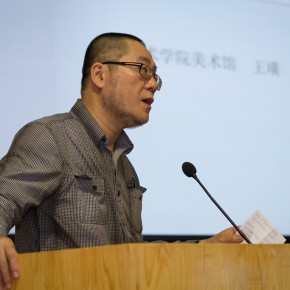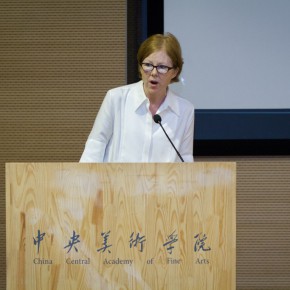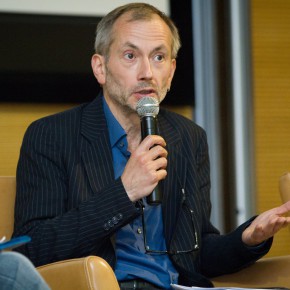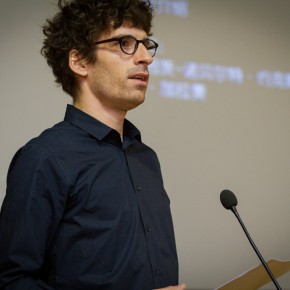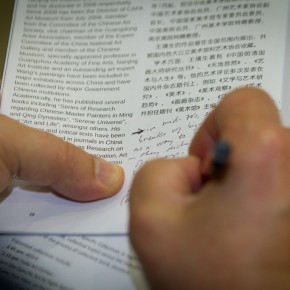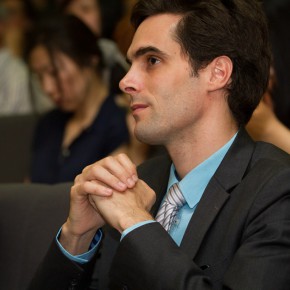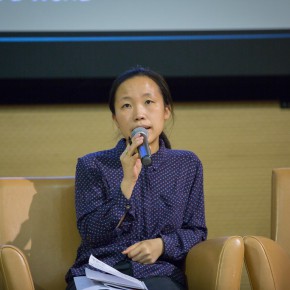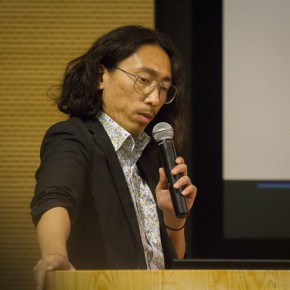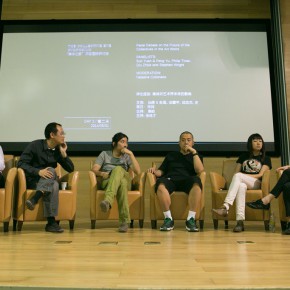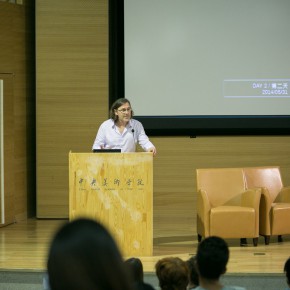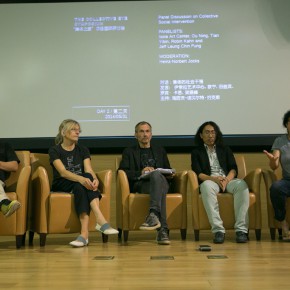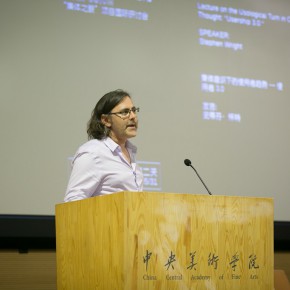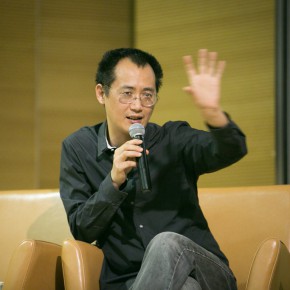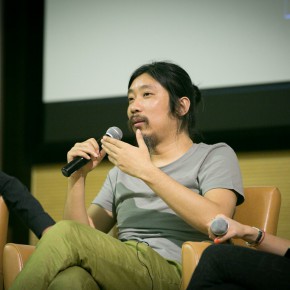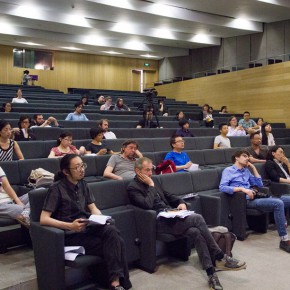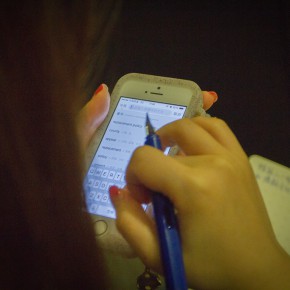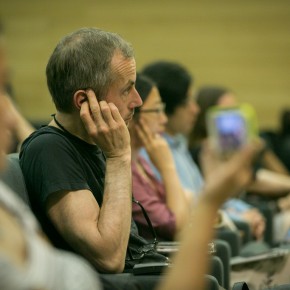
“The Collective Eye” Symposium No.1 - On the Differences of Collective Practice
At 10:00 am on May 30, 2014, three days of “The Collective Eye - Group Subjectivity and Its Aesthetics in the Light of Cultural Differences” symposium opened at the Auditorium of CAFA Art Museum. The symposium on the first day unfolded around the topic “on the Differences of Collective Practice”.
Peter Anders, Director of the Goethe-Institut China, and Anthony Chaumuzeau, Counselor (Culture, Education and Cooperation), Director of the French Institute in China initially addressed the audience at the opening. Anders said, this activity was supported by the German Cultural Foundation and the CAFA Art Museum, and it discussed the “collective” issue, trying to study the different expressions of collective organizations in a public space.
German writer, art critic and curator Heinz-Norbert Jocks and Dominique Lucien Garaudel introduced “The Collective Eye” project. In October 2012, “The Collective Eye” project was established in Montevideo, attempting to become a project organization where the academic circles in different countries got together for international cooperation, which began to promote a mutual dialogue between art groups and theorists three years ago, intentionally shifting the research focus towards collective cultural differences. The symposium invited art teams, critics, philosophers, and historians of art, so that it was an open project. That the symposium takes place in China also has to do with the fact that the concept of the collective plays a different role there with regards to historical materialism. At the same time it was an academic preparation for the art group’s exhibition which is about to be held in China in 2015.
Subsequently, Curator Wang Huangsheng formally opened the prelude to the symposium by giving a lecture entitled “The Small Collective Challenging the Big Collective”. Curator Wang said, the art groups that emerged in the form of a gathering or collective in various specific historical periods, all consciously played a role in fighting against and challenging collective society, politics, ideology and the power of the collective structure, they hoped to use the power and way of the small “collective” to resist and challenge the“big collective”.
Then the famous contemporary art critic and curator Ms. Karen Smith gave a lecture on the “History of Groups in China from the Perspective of Collective Societies and Social Existence in China”. Karen Smith initially talked about a variety of art teams, art events and the representative artists since the 1980s, systematically combing through the developing history of the Chinese collective art, and exploring the relationship between Chinese art groups and the individuals, as well as the form and process used by the organizations to replace the collectives.
At the end of the first half of the activity, there was a dialogue between Heinz-Norbert Jocks and Frédéric Rambeau, on the “Influence of Sartre and Deleuze on Collective Practice”. They discussed on the collective subjectivity and the political subjective in the works by Deleuze and Guattari. Frédéric Rambeau believed that there was a paradox within the collective, on the one hand,
It fulfilled the desire for the social existence, on the other hand, it also reserved the revolutionary thoughts of the collective.
In the second half, it mainly discussed the motivation to promote the forming of the collective, the contradiction between the collective issue and individual interest, the nature of the process of collective practice and other issues. Participating guests included artists Tian Yibin, Sun Yuan, critic Karen Smith, as well as art teams, collectives, and the organizations, such as AES + F from Russia, and Qu Yizhen, a representative of Isola Art Center from Milan.
Before the start of the discussion, the French artist Alain Snyers gave a speech entitled “Working Together, Getting along Together - Common Behavior”, Alain regarded his own experiences as the main event, introducing some French art groups and their status, and he believed that the group allowed artists to work together, with the collective power they could do better in practicing the material, strategic and political purposes.
Chinese artist Tian Yibin played his video “In New York and Elsewhere” and explained it to the audience. Then the couple of Sun Yuan and Peng Yu discussed “what is a collective (art group), why and what form of activity should the arts groups take”, etc. For the couple, artists were extreme individuals, who came together because of similar interests, and they would be faced with dissolution at the end.
“The Collective Eye” Symposium No.2 – How Does Culture Influence the Artistic Work of a Collective?
On the morning on May 31, 2014, the second session of “The Collective Eye - Group Subjectivity and Its Aesthetics in the Light of Cultural Differences” symposium invited artists, curators, art groups from different countries, regions to discuss the issue “How Does Culture Influence The Artistic Work of a Collective?”.
Su Wei & Carol Yinghua Lu & Liu Ding: Low Pitch - the Art Practice and Spiritual Trajectory of Historical Transformation
First of all Carol Lu introduced the individual work directions of the three members. Su Wei was opposed to the definitions of some things, because he thought definition was a kind of strengthened order, for example, he didn’t agree with the cooperation with Carol Lu and Liu Dingas an art team. For example, the narrative of Chinese contemporary art history was an history of successful people, to strengthen order and logic that had hurt the individual creativity and led to the hesitation and anxiety of the creation.
NBDBKP team
NBDBKP art team from Berlin, Germany was made up of Niels Betori Diehl and Barbara K.Proko, who both graduated from Berlin University of the Arts, were in cooperation to plan a series of large scale interdisciplinary exhibitions since 2006. First of all they proposed some issues, such as, was there any difference between cooperative and collective creation? The two artists did not immediately or clearly answer these issues, but shared their cooperative experiences with the audience. They both believed that, the reason why they maintained a cooperative relationship was firstly based on the common idea, although they worked together, it couldn’t be strictly defined as an art team.
Song Yi and Jeff Leung Chin Fung: Presentation on Collective Art Scenes and Social Intervention Practices in Hong Kong
Hong Kong curator Jeff Leung Chin Fung introduced some art activities presented in Hong Kong urban space in recent years. He said Hong Kong art practices were ordinarily thought to follow a fixed pattern, such as having a relationship with the market, or social movements. But he put forward the third path between the two poles, namely spatial imagination. The artistic practice of the third path mainly came from the younger generation, rather than caring about the developing size of the organization, they preferred to take an easygoing way in organising without any systematic disturbance.
In the finial discussion section, several art teams from different continents came together to discuss what the geographical and cultural differences did to influence their collective creation, as well as the changes of collective creations, with the change of the city.
“The Collective Eye” Symposium No.3 - The “Utopian Surplus” of the Collective
In the afternoon of May 31, 2014, the exhibition unfolded two keynote speeches and three panel discussions, which pushed the conference to a new high.
Ou Ning’s speech “The Collectivism as a Practical Utopia” unveiled the curtain for the afternoon seminar. Ou Ning is a very active cultural activist in China, and he was a founder of the Bishan Community project in 2011, exploring how to build a “Utopia” in the country. Ou Ning thought that collectivism was the natural trend of the collective living as an human in a social community, but collectivism didn’t mean that the individual value was submerged, instead, synchronising with the emphasis on individual value and revealing a way of life for people as a community.
Stephen Wright is a writer from Canada, and has focused primarily on the politics of users, particularly in the contexts of collaborative, extra-disciplinary practices with variable coefficients of art. He said it was impossible for a person to adjust the “toolbox” of language, so that it was in need of a group, and working together.
After two wonderful keynote speeches, there were three panel debates between the guests, and Ou Ning, Robin Kahn, Jeff Leung Chin Fung, Qiu Zhijie, Bao Dong, Sun Yuan, Peng Yu, Stephen Wright, and so on, respectively expressed their own ideas, individual research and knowledge on the “Collective Social Intervention”, “Curatorial Work within the Context of Artist Collectives”, and the “Future of the Collectives in the Art World”.
Robin Kahn said that, as an artist he needed to become a part of the collective, in order to promote his own creation, which was certainly only his personal choice. Bao Dong said that the establishment of an art team was actually an act to optimize the resource, while many individual voices in the art teams seemed to be submerged. Gao Minglu had also studied this topic, and he thought that the individual would be freer in a collective, and with a sense of belonging.
“The Collective Eye” Symposium - The “Utopian Surplus” of the Collective successfully ended, in addition, on June 1, it held the final session of “The Collective Eye”, on the “Cultural Differences in Global Times”.
Text: Ye Yuanfeng, Zhang Wenzhi, Huang Bihe/CAFA ART INFO
Translated by Chen Peihua and edited by Sue/CAFA ART INFO
Photo: Hu Zhiheng, Quan Jing/ CAFA ART INFO


